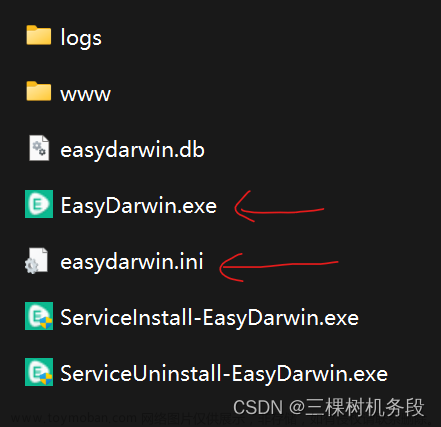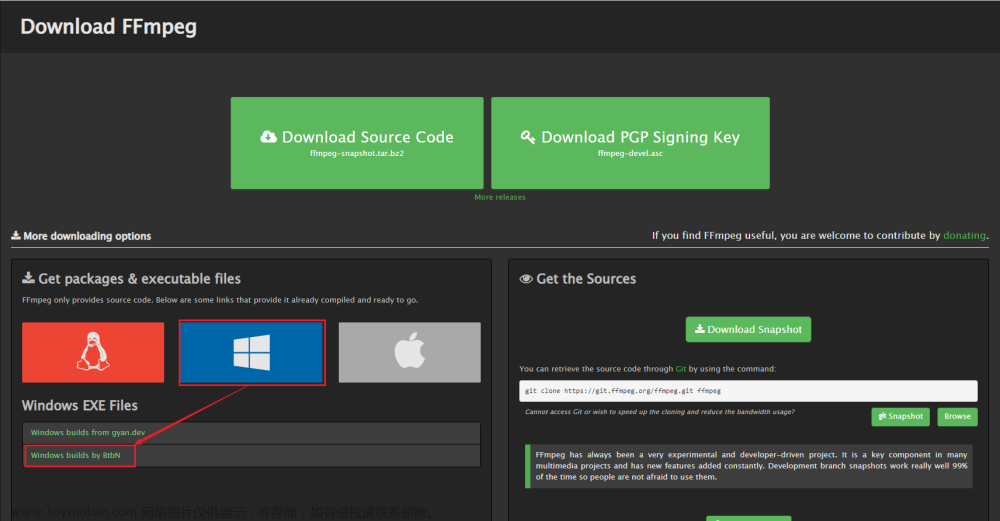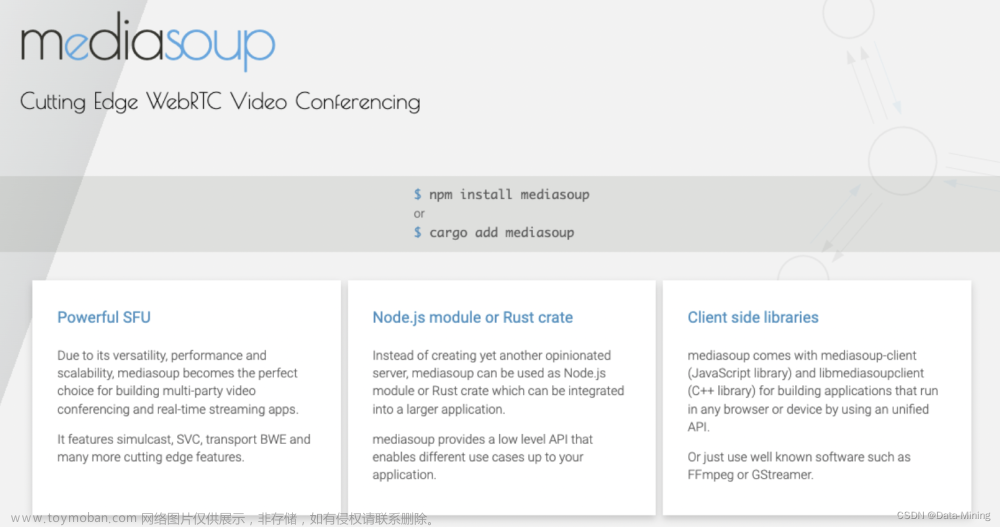1. 简介
流媒体是使用了流式传输的多媒体应用技术。如下是维基百科关于流媒体概念的定义:
流媒体 (streaming media) 是指将一连串的媒体数据压缩后,经过网络分段发送数据,在网络上即时传输影音以供观赏的一种技术与过程,此技术使得数据包得以像流水一样发送;如果不使用此技术,就必须在使用前下载整个媒体文件。
1.1 FFmpeg 影音处理的层次
FFmpeg 中对影音数据的处理,可以划分为协议层、容器层、编码层与原始数据层四个层次:
协议层:提供网络协议收发功能,可以接收或推送含封装格式的媒体流。协议层由 libavformat 库及第三方库(如 librtmp)提供支持。
容器层:处理各种封装格式。容器层由 libavformat 库提供支持。
编码层:处理音视频编码及解码。编码层由各种丰富的编解码器(libavcodec 库及第三方编解码库(如 libx264))提供支持。
原始数据层:处理未编码的原始音视频帧。原始数据层由各种丰富的音视频滤镜(libavfilter 库)提供支持。
本文提及的收流与推流的功能,属于协议层的处理。
FFmpeg 中 libavformat 库提供了丰富的协议处理及封装格式处理功能,在打开输入/输出时,FFmpeg 会根据 输入 URL / 输出 URL 探测输入/输出格式,选择合适的协议和封装格式。例如,如果输出 URL 是 "rtmp://192.168.0.104/live",那么 FFmpeg 打开输出时,会确定使用 rtmp 协议,封装格式为 flv。
FFmpeg 中打开输入/输出的内部处理细节用户不必关注,因此本文流处理的例程和前面转封装的例程非常相似,不同之处主要在于输入/输出 URL 形式不同,若 URL 携带 "rtmp://"、"rpt://"、"udp://"等前缀,则表示涉及流处理;否则,处理的是本地文件。
1.2 流媒体系统中的角色
流媒体系统是一个比较复杂的系统,简单来说涉及三个角色:流媒体服务器、推流客户端和收流客户端。推流客户端是内容生产者,收流客户端是内容消费者。示意图如下:
1.3 收流与推流
如果输入是网络流,输出是本地文件,则实现的是收流功能,将网络流存储为本地文件,如下:
如果输入是本地文件,输出是网络流,则实现的是推流功能,将本地文件推送到网络,如下:
如果输入是网络流,输出也是网络流,则实现的是转流功能,将一个流媒体服务器上的流推送到另一个流媒体服务器,如下:
2. 源码
源码和转封装例程大部分相同,可以认为是转封装例程的增强版:
#include <stdbool.h>
#include <libavutil/timestamp.h>
#include <libavformat/avformat.h>
// ffmpeg -re -i tnhaoxc.flv -c copy -f flv rtmp://192.168.0.104/live
// ffmpeg -i rtmp://192.168.0.104/live -c copy tnlinyrx.flv
// ./streamer tnhaoxc.flv rtmp://192.168.0.104/live
// ./streamer rtmp://192.168.0.104/live tnhaoxc.flv
int main(int argc, char **argv)
{
AVOutputFormat *ofmt = NULL;
AVFormatContext *ifmt_ctx = NULL, *ofmt_ctx = NULL;
AVPacket pkt;
const char *in_filename, *out_filename;
int ret, i;
int stream_index = 0;
int *stream_mapping = NULL;
int stream_mapping_size = 0;
if (argc < 3) {
printf("usage: %s input output\n"
"API example program to remux a media file with libavformat and libavcodec.\n"
"The output format is guessed according to the file extension.\n"
"\n", argv[0]);
return 1;
}
in_filename = argv[1];
out_filename = argv[2];
// 1. 打开输入
// 1.1 读取文件头,获取封装格式相关信息
if ((ret = avformat_open_input(&ifmt_ctx, in_filename, 0, 0)) < 0) {
printf("Could not open input file '%s'", in_filename);
goto end;
}
// 1.2 解码一段数据,获取流相关信息
if ((ret = avformat_find_stream_info(ifmt_ctx, 0)) < 0) {
printf("Failed to retrieve input stream information");
goto end;
}
av_dump_format(ifmt_ctx, 0, in_filename, 0);
// 2. 打开输出
// 2.1 分配输出ctx
bool push_stream = false;
char *ofmt_name = NULL;
if (strstr(out_filename, "rtmp://") != NULL) {
push_stream = true;
ofmt_name = "flv";
}
else if (strstr(out_filename, "udp://") != NULL) {
push_stream = true;
ofmt_name = "mpegts";
}
else {
push_stream = false;
ofmt_name = NULL;
}
avformat_alloc_output_context2(&ofmt_ctx, NULL, ofmt_name, out_filename);
if (!ofmt_ctx) {
printf("Could not create output context\n");
ret = AVERROR_UNKNOWN;
goto end;
}
stream_mapping_size = ifmt_ctx->nb_streams;
stream_mapping = av_mallocz_array(stream_mapping_size, sizeof(*stream_mapping));
if (!stream_mapping) {
ret = AVERROR(ENOMEM);
goto end;
}
ofmt = ofmt_ctx->oformat;
AVRational frame_rate;
double duration;
for (i = 0; i < ifmt_ctx->nb_streams; i++) {
AVStream *out_stream;
AVStream *in_stream = ifmt_ctx->streams[i];
AVCodecParameters *in_codecpar = in_stream->codecpar;
if (in_codecpar->codec_type != AVMEDIA_TYPE_AUDIO &&
in_codecpar->codec_type != AVMEDIA_TYPE_VIDEO &&
in_codecpar->codec_type != AVMEDIA_TYPE_SUBTITLE) {
stream_mapping[i] = -1;
continue;
}
if (push_stream && (in_codecpar->codec_type == AVMEDIA_TYPE_VIDEO)) {
frame_rate = av_guess_frame_rate(ifmt_ctx, in_stream, NULL);
duration = (frame_rate.num && frame_rate.den ? av_q2d((AVRational){frame_rate.den, frame_rate.num}) : 0);
}
stream_mapping[i] = stream_index++;
// 2.2 将一个新流(out_stream)添加到输出文件(ofmt_ctx)
out_stream = avformat_new_stream(ofmt_ctx, NULL);
if (!out_stream) {
printf("Failed allocating output stream\n");
ret = AVERROR_UNKNOWN;
goto end;
}
// 2.3 将当前输入流中的参数拷贝到输出流中
ret = avcodec_parameters_copy(out_stream->codecpar, in_codecpar);
if (ret < 0) {
printf("Failed to copy codec parameters\n");
goto end;
}
out_stream->codecpar->codec_tag = 0;
}
av_dump_format(ofmt_ctx, 0, out_filename, 1);
if (!(ofmt->flags & AVFMT_NOFILE)) { // TODO: 研究AVFMT_NOFILE标志
// 2.4 创建并初始化一个AVIOContext,用以访问URL(out_filename)指定的资源
ret = avio_open(&ofmt_ctx->pb, out_filename, AVIO_FLAG_WRITE);
if (ret < 0) {
printf("Could not open output file '%s'", out_filename);
goto end;
}
}
// 3. 数据处理
// 3.1 写输出文件头
ret = avformat_write_header(ofmt_ctx, NULL);
if (ret < 0) {
printf("Error occurred when opening output file\n");
goto end;
}
while (1) {
AVStream *in_stream, *out_stream;
// 3.2 从输出流读取一个packet
ret = av_read_frame(ifmt_ctx, &pkt);
if (ret < 0) {
break;
}
in_stream = ifmt_ctx->streams[pkt.stream_index];
if (pkt.stream_index >= stream_mapping_size ||
stream_mapping[pkt.stream_index] < 0) {
av_packet_unref(&pkt);
continue;
}
int codec_type = in_stream->codecpar->codec_type;
if (push_stream && (codec_type == AVMEDIA_TYPE_VIDEO)) {
av_usleep((int64_t)(duration*AV_TIME_BASE));
}
pkt.stream_index = stream_mapping[pkt.stream_index];
out_stream = ofmt_ctx->streams[pkt.stream_index];
/* copy packet */
// 3.3 更新packet中的pts和dts
// 关于AVStream.time_base(容器中的time_base)的说明:
// 输入:输入流中含有time_base,在avformat_find_stream_info()中可取到每个流中的time_base
// 输出:avformat_write_header()会根据输出的封装格式确定每个流的time_base并写入文件中
// AVPacket.pts和AVPacket.dts的单位是AVStream.time_base,不同的封装格式AVStream.time_base不同
// 所以输出文件中,每个packet需要根据输出封装格式重新计算pts和dts
av_packet_rescale_ts(&pkt, in_stream->time_base, out_stream->time_base);
pkt.pos = -1;
// 3.4 将packet写入输出
ret = av_interleaved_write_frame(ofmt_ctx, &pkt);
if (ret < 0) {
printf("Error muxing packet\n");
break;
}
av_packet_unref(&pkt);
}
// 3.5 写输出文件尾
av_write_trailer(ofmt_ctx);
end:
avformat_close_input(&ifmt_ctx);
/* close output */
if (ofmt_ctx && !(ofmt->flags & AVFMT_NOFILE)) {
avio_closep(&ofmt_ctx->pb);
}
avformat_free_context(ofmt_ctx);
av_freep(&stream_mapping);
if (ret < 0 && ret != AVERROR_EOF) {
printf("Error occurred: %s\n", av_err2str(ret));
return 1;
}
return 0;
}
2.1 收流
收流的代码与打开普通文件的代码没有区别,打开输入时,FFmpeg 能识别流协议及封装格式,根据相应的协议层代码来接收流,收到流数据去掉协议层后得到的数据和普通文件内容是一样的,后续的处理流程也就一样了。
2.2 推流
推流有两个需要注意的地方。
一是需要根据输出流协议显式指定输出 URL 的封装格式:
bool push_stream = false;
char *ofmt_name = NULL;
if (strstr(out_filename, "rtmp://") != NULL) {
push_stream = true;
ofmt_name = "flv";
}
else if (strstr(out_filename, "udp://") != NULL) {
push_stream = true;
ofmt_name = "mpegts";
}
else {
push_stream = false;
ofmt_name = NULL;
}
avformat_alloc_output_context2(&ofmt_ctx, NULL, ofmt_name, out_filename);
这里只写了两种。rtmp 推流必须推送 flv 封装格式,udp 推流必须推送 mpegts 封装格式,其他情况就当作是输出普通文件。这里使用 push_stream 变量来标志是否使用推流功能,这个标志后面会用到。
二是要注意推流的速度,不能一股脑将收到的数据全推出去,这样流媒体服务器承受不住。可以按视频播放速度(帧率)来推流。因此每推送一个视频帧,要延时一个视频帧的时长。音频流的数据量很小,可以不必关心此问题。
在打开输入 URL 时,获取视频帧的持续时长:
AVRational frame_rate;
double duration;
if (push_stream && (in_codecpar->codec_type == AVMEDIA_TYPE_VIDEO)) {
frame_rate = av_guess_frame_rate(ifmt_ctx, in_stream, NULL);
duration = (frame_rate.num && frame_rate.den ? av_q2d((AVRational){frame_rate.den, frame_rate.num}) : 0);
}
在 av_read_frame() 之后,av_interleaved_write_frame() 之前增加延时,延时时长就是一个视频帧的持续时长:
int codec_type = in_stream->codecpar->codec_type;
if (push_stream && (codec_type == AVMEDIA_TYPE_VIDEO)) {
av_usleep((int64_t)(duration*AV_TIME_BASE));
}
3. 验证
3.1 编译第三方库 librtmp
FFmpeg 默认并不支持 rtmp 协议。需要先编译安装第三方库 librtmp,然后开启 --enable-librtmp 选项重新编译安装 FFmpeg。
3.2 搭建流媒体服务器
测试收流与推流功能需要搭建流媒体服务器。我们选用 nginx-rtmp 作为流媒体服务器用于测试。nginx-rtmp 服务器运行于虚拟机上,推流客户端与收流客户端和 nginx-rtmp 服务器处于同一局域网即可。我的虚拟机是 OPENSUSE LEAP 42.3,IP 是 192.168.0.104(就是 nginx-rtmp 服务器的地址)。
为避免搭建服务器的繁琐过程,我们直接使用 docker 拉取一个 nginx-rtmp 镜像。步骤如下:
[1] 安装与配置docker服务
安装 docker:
sudo zypper install docker
将当前用户添加到 docker 组(若 docker 组不存在则先创建),从而可以免 sudo 使用 docker 命令:
sudo gpasswd -a ${USER} docker
[2] 配置镜像加速
docker 镜像源位于美国,摘取镜像非常缓慢。可配置国内镜像源,加快镜像拉取速度。
修改 /etc/docker/daemon.json 文件并添加上 registry-mirrors 键值:
{
"registry-mirrors":
[
"https://registry.docker-cn.com",
"https://docker.mirrors.ustc.edu.cn",
"https://hub-mirror.c.163.com",
"https://mirror.ccs.tencentyun.com"
]
}
上述配置文件添加了四个国内镜像源:docker 中国、清华、163 和腾讯。
修改配置文件后重启 docker 服务:
systemctl restart docker
[3] 拉取 nginx-rtmp 镜像
docker pull tiangolo/nginx-rtmp
[4] 打开容器
docker run -d -p 1935:1935 --name nginx-rtmp tiangolo/nginx-rtmp
[5] 防火墙添加例外端口
如果无法推流,应在防火墙中将 1935 端口添加例外
openSUSE 系统:修改 /etc/sysconfig/SuSEfirewall2 文件,在 FW_SERVICES_EXT_TCP 项中添加 1935 端口,如下:
FW_SERVICES_EXT_TCP="ssh 1935"
然后重启防火墙:
systemctl restart SuSEfirewall2
CentOS 8 系统:运行如下命令将 1935 端口添加到防火墙例外端口中:
firewall-cmd --permanent --zone=public --add-port=1935/tcp
[6] 验证服务器
测试文件下载(右键另存为):tnhaoxc.flv
ffmpeg 推流测试:
ffmpeg -re -i tnhaoxc.flv -c copy -f flv rtmp://192.168.0.104/live
"-re":按视频帧率的速度读取输入 "-c copy":输出流使用和输入流相同的编解码器 "-f flv":指定输出流封装格式为flv
ffplay 收流播放测试:
ffplay rtmp://192.168.0.104/live
ffplay 播放正常,说明 nginx-rtmp 流媒体服务器搭建成功,可正常使用。
3.3 编译
在 shell 中运行如下命令下载例程源码:
svn checkout https://github.com/leichn/exercises/trunk/source/ffmpeg/ffmpeg_stream
在源码目录执行 ./compile.sh 命令,生成 streamer 可执行文件。
3.4 验证
测试文件下载(右键另存为):shifu.mkv,将测试文件保存在和源码同一目录。
推流测试:
./streamer shifu.mkv rtmp://192.168.0.104/live
使用 vlc 播放器打开网络串流,输入流地址 "rtmp://192.168.0.104/live",播放正常。上述测试命令等价于:
ffmpeg -re -i shifu.mkv -c copy -f flv rtmp://192.168.0.104/live
收流测试:先按照上一步命令启动推流,然后运行如下命令收流
./streamer rtmp://192.168.0.104/live shifu.ts
以上测试命令等价于:
ffmpeg -i rtmp://192.168.0.104/live -c copy shifu.ts
接收结束后检查一下生成的本地文件 shifu.ts 能否正常播放。
4. 遗留问题
推流的问题:不管是用 ffmpeg 命令,还是用本测试程序,推流结束时会打印如下信息
文章来源:https://www.toymoban.com/news/detail-502547.html
[flv @ 0x22ab9c0] Timestamps are unset in a packet for stream 0. This is deprecated and will stop working in the future. Fix your code to set the timestamps properly
Larger timestamp than 24-bit: 0xffffffc2
[flv @ 0x22ab9c0] Failed to update header with correct duration.
[flv @ 0x22ab9c0] Failed to update header with correct filesize.
收流的问题:推流结束后,收流超时未收以数据,会打印如下信息后程序退出运行文章来源地址https://www.toymoban.com/news/detail-502547.html
RTMP_ReadPacket, failed to read RTMP packet header
到了这里,关于FFmpeg流媒体处理的收流与推流的文章就介绍完了。如果您还想了解更多内容,请在右上角搜索TOY模板网以前的文章或继续浏览下面的相关文章,希望大家以后多多支持TOY模板网!













